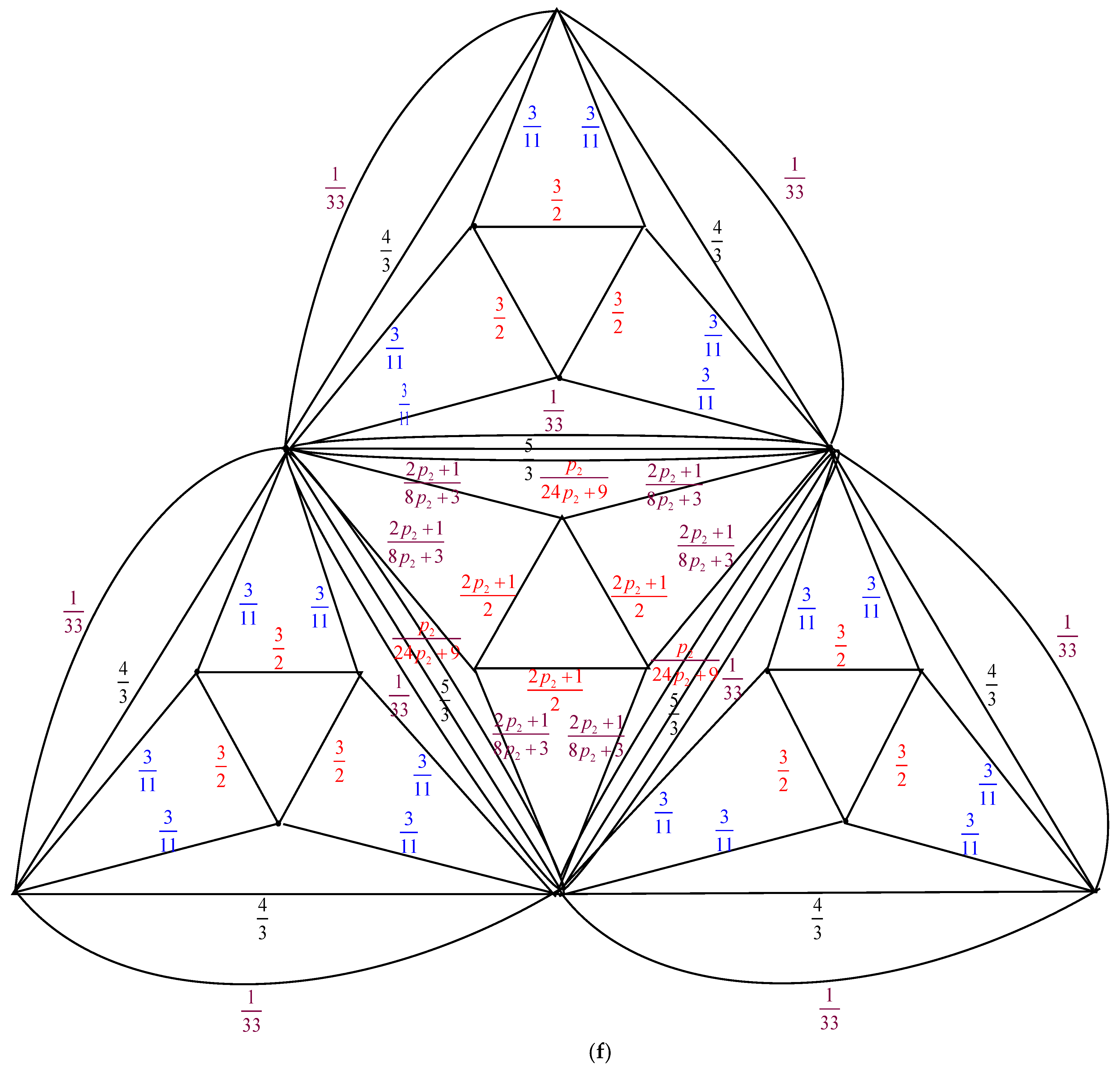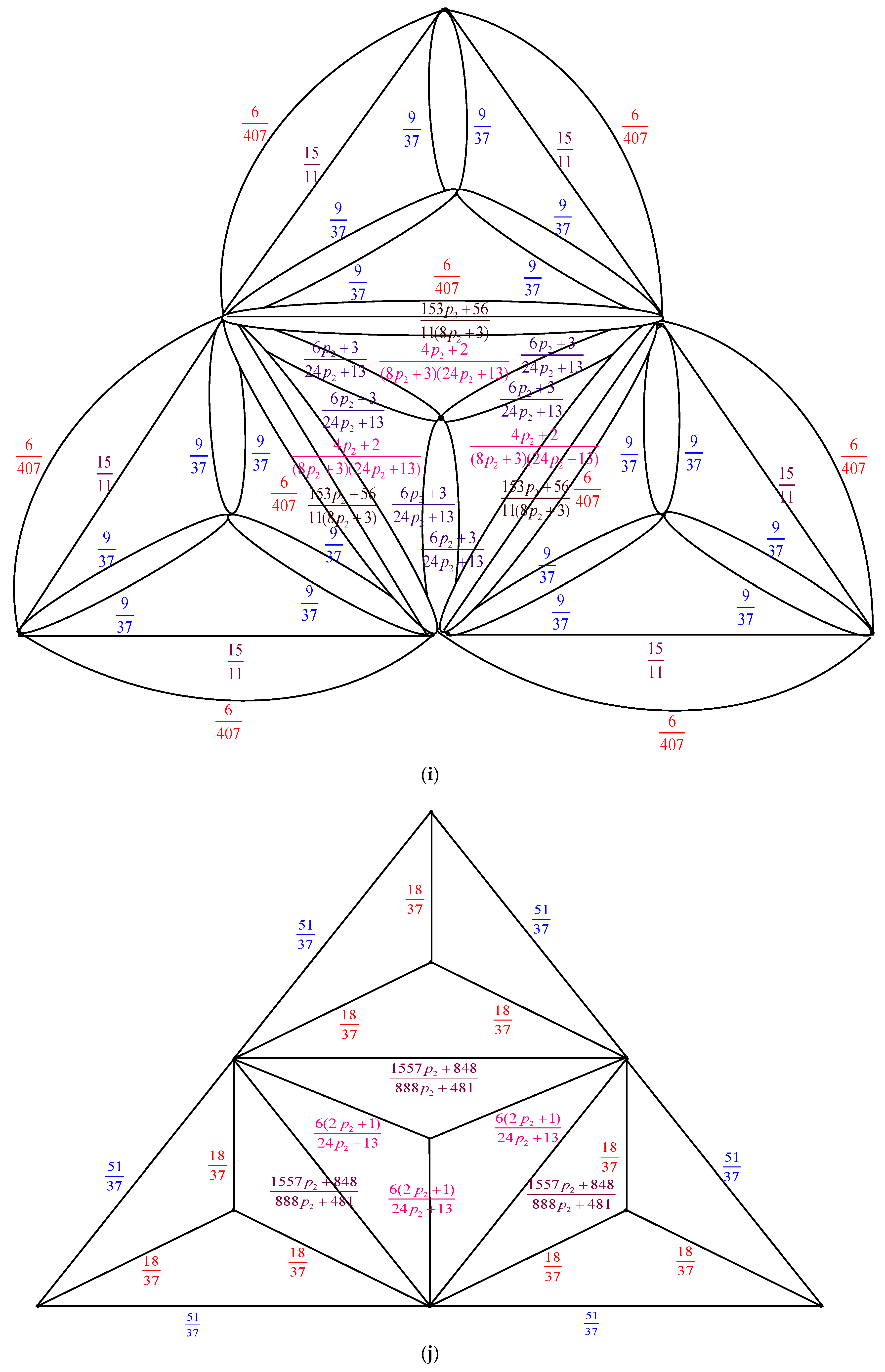1. Introduction
A spanning tree is a subgraph of an undirected, connected graph that has every vertex in the main graph but only employs the fewest required edges to construct a tree structure (i.e., no cycles). It essentially connects every node in a network without generating unnecessary loops.
These days, physics has a function τ where the number of spanning trees
is employed as an invariant to calculate the entropy of certain networks associated with physical processes [
1,
2,
3]. In the discipline of network analysis [
4,
5,
6],
is also used in relation to other metrics that show how reliable a network is when represented by graph
. Furthermore, there are numerous mathematical uses for the number of spanning trees τ(G). The current fastest approach, for instance, employs the scaling factor of the coordinate system to embed a three-connected planar graph as a
polytope. There are many subgraphs within a fixed graph
. A graph with
edges can actually have
different subgraphs. Some of these subgraphs are obviously trees. We are especially interested in a subset of these trees known as spanning trees. The practice of counting the number of spanning trees
of a graph
dates to 1842, when German mathematician Gustav Kirchhoff [
7] established a connection between the number of spanning trees of a graph
and the determinant of a particular submatrix that is connected to it as follows:
For a connected graph
with
vertices, the Kirchhoff matrix
is an
characteristic matrix
, where
is the adjacency matrix of
, and
is the diagonal matrix of the degrees of
, such that
is defined as follows:
The number of spanning trees in a graph is equal to each co-factor of .
For big graphs, this approach is not practical. Because of this, people have devised ways to overcome challenges and have focused more on obtaining clear and straightforward formulas for certain classes of graphs. See [
8,
9,
10]. Daoud [
11] developed this technique and derived the explicit formula for counting the number of spanning trees of cartesian and composition products of complete and complete bipartite and tripartite graphs as well as the explicit formula for counting the number of spanning trees of classes of pyramid graphs generated by wheel and gear graphs [
12].
Feussner’s recursive formula [
13,
14], the fundamental combinatorial concept for counting
in a graph
, is very simple to understand. Let
be any edge of an undirected simple graph
. Each spanning tree in
can be divided into two sections: all spanning trees without
as a tree edge are included in one section, and all spanning trees with
as a tree edge are included in the other.
The subgraph that results from taking a graph and removing an edge while leaving all other edges and vertices intact is represented by the first section, which has the same number of spanning trees as the graph. In the second section, the graph (not a subgraph) is created by compressing the edge until the two vertices and meet, and it has the same number of spanning trees as the graph. This new vertex is identified by
Compared to
, both
and
have fewer edges. Thus, it is possible to count the number of spanning trees in
in a recursive manner. Assume now that
represents the collection of all spanning trees of
; thus
This set consequently broke down into two disjoint sets
, one of which
consists of trees containing selected edge
, while the other
consists of trees that do not contain
. It is evident that
since every edge of them matches a spanning tree of
and
, because every one of its edges is a spanning tree of
and inversely,
. In 1889, British mathematician A. Cayley [
15] determined how many spanning trees there are in a full graph:
. It was demonstrated using a variety of methods, including some combinatorial techniques [
16]. The explicit formula for calculating the number of spanning trees of chain graphs and wheel-related graphs was derived by Daoud [
17,
18] using this technique.
3. Main Results
A Johnson graph is a specific kind of undirected graph that is defined using systems of sets. Two vertices (subsets) are close when they meet and contain -elements. The element subsets of an element collection are the vertices of the Johnson graph . In other words, the Johnson graph has vertices given by the k-subsets of , with two vertices connected if and only if their intersection has size . The Johnson skeleton graph is a minimal unit-distance forbidden graph.
This study will identify the number of spanning trees in the graph sequences, , generated by the Johnson skeleton graph 63 and two related graph sequences, and , generated by two graphs associated with Johnson skeleton graph 63; these are defined as follows:
The first Johnson-skeleton-related graph is a graph that is produced by replacing the internal triangle of Johnson skeleton graph 63 with a star (3,3)-gon graph. See
Figure 1b.
The second Johnson-skeleton-related graph is a graph that is produced by replacing the internal triangle of Johnson skeleton graph 63 with another Johnson skeleton graph 63. See
Figure 1c.
3.1. The Number of Spanning Trees in the Graph Sequence
The graph sequence
is a recursive definition using the graphs
and
(triangle or
): A replica of
is used in place of the middle triangle of
to create the graph
. The central triangle in the graph
is typically swapped out for
to make
as shown in
Figure 2.
and
are the total vertices and edges of
, respectively. According to this architecture in the large
limit, the average degree of
is 4.
Theorem 1. For , the number of spanning trees in the graph sequence is determined by Proof. We convert
to
using the electrically equivalent transformation. The process of change from
to
is depicted in
Figure 3.
When the ten adjustments listed above are combined, we obtain
Further
where
The characteristic equation for this is like
with roots
and
. When two roots are subtracted from both sides of
, we get
Let
. Then, by Equations (3) and (4), we get
and
. Therefore,
Thus
Using the formula
and denoting the coefficients of
and
as
and
, we have
Thus, we get
where
and
. By the expression
and using Equations (6) and (7), we have
Equation (9) has a characteristic equation of
with roots
and
. The general solutions of Equation (9) are
. Using the initial conditions
and
, yields
Should
is devoid of any electrically equivalent transformation. Entering (10) into Equation (8), we get
When
,
, which satisfies Equation (11). Therefore, the number of spanning trees in the sequence of the graph
is given by
where
Equation (13) is inserted into Equation (12), yielding the desired result. □
3.2. The Number of Spanning Trees in the Graph Sequence
The graph sequence
is a recursive definition using the graphs
and
(triangle or
): A replica of
is used in place of the middle triangle of
to create the graph
. The central triangle in the graph
is typically swapped out for
to make
, as shown in
Figure 4.
and
are the total vertices and edges of
, respectively. According to this architecture in the large
limit, the average degree of
is
.
Theorem 2. For , the number of spanning trees in the sequence of the graph is given by Proof. We convert
to
using the electrically equivalent transformation. The process of change from
to
is depicted in
Figure 5.
When the sixteen modifications mentioned above are combined, the result is:
Further
where
Its characteristic equation is
with roots
and
. Subtracting these two roots into both sides of
, we get
Let . Then by Equations (16) and (17), we get and .
Using the expression
and denoting the coefficients of
and
as
and
, we have
Thus, we obtain
where
and
. By the expression
and using Equations (19) and (20), we have
The characteristic equation of Equation (22) is
with roots
and
. The general solutions of Equation (22) are
. Using the initial conditions
and
, yields
If
, it means that
is without any electrically equivalent transformation. Plugging Equation (23) into Equation (21), we have
When
,
, which satisfies Equation (24). Therefore, the number of spanning trees in the sequence of the graph
is given by
where
Equation (26) is inserted into Equation (25), yielding the desired outcome. □
3.3. The Number of Spanning Trees in the Graph Sequence
The graph sequence
is a recursive definition using the graphs
and
(triangle or
): A replica of
is used in place of the middle triangle of
to create the graph
. The central triangle in the graph
is typically swapped out for
to make
, as shown in
Figure 6.
and
are the total vertices and edges of
, respectively. According to this architecture in the large
limit, the average degree of
is
.
Theorem 3. For , the number of spanning trees in the graph sequence is given by Proof. We convert
to
using the electrically equivalent transformation. The process of change from
to
is depicted in
Figure 7.
When the seventeen modifications mentioned above are combined, the result is:
Further
where
Its characteristic equation is
with roots are
and
. Subtracting these two roots into both sides of
, we get
Let
. Then, by Equations (29) and (30), we get
Using the expression
and denoting the coefficients of
and
as
and
, we have
Thus, we obtain
where
and
. By the expression
and using Equations (32) and (33), we have
The characteristic equation of Equation (35) is
with roots
and
. The general solutions of Equation (35) are
. Using the initial conditions
and
, yields
If
, it means that
is without any electrically equivalent transformation. Plugging Equation (36) into Equation (34), we have
When
,
, which satisfies Equation (37). Therefore, the number of spanning trees in the sequence of the graph
is given by
where
Equation (39) can be inserted into Equation (38), yielding the desired result. □
5. Spanning Tree Entropy
Once we have exact formulas for the number of spanning trees of the three sequence graphs
,
, and
, we can compute the spanning tree entropy Z, a finite number, and an interesting metric defining the network topology. In [
10,
22], this is explained as follows: Regarding graph
,
We now compare our sequence graphs’ entropy values to those of other graphs. It is evident that the
graph has a higher entropy than the other two graphs, whereas the
graph has a lower entropy. Furthermore, the entropy of the two-dimensional Sierpinski gasket [
23] and the fractal scale free lattice [
20] both have entropies of 1.166 and 1.040 and are of the same average degree 4, respectively, while the entropy of the
graph is greater than that of the fractal scale free lattice and lower than that of the two dimensional Sierpinski gasket.
































